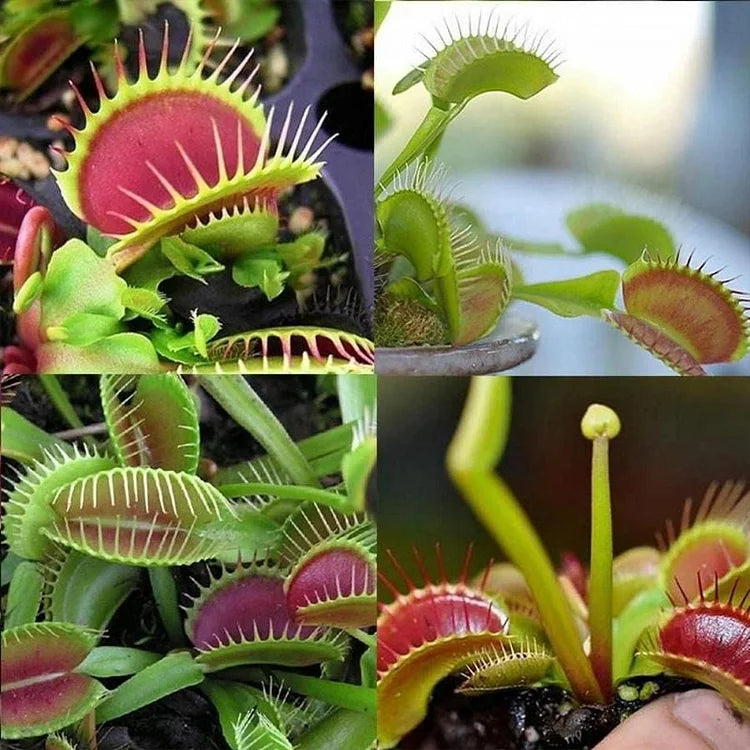
Dharaseeds
Venus Fllytrap Seeds
Estimated Free Delivery between April 16 and April 19.
Secured Payment Methods
Your transaction is protected with advanced security measures to keep your information confidential
The Venus Flytrap (Dionaea muscipula) is one of the most fascinating and popular carnivorous plants, known for its unique mechanism of catching prey using modified leaves that snap shut when triggered. Growing your own Venus Flytrap from seed is a rewarding experience, allowing you to witness the full life cycle of this extraordinary plant. With its ability to trap insects, the Venus Flytrap is not only a captivating addition to any garden or home, but it also helps control pests naturally.
Key Benefits
Natural Pest Control: Venus Flytraps trap and digest insects, providing a natural form of pest control for your garden or home.
Educational Value: A great plant for teaching children and plant enthusiasts about carnivorous plants and their unique adaptations.
Low Maintenance: Once established, Venus Flytraps are relatively easy to care for, thriving in specific conditions with minimal effort.
Aesthetic Appeal: The plant's unique, mouth-like traps and striking green color add a touch of intrigue and beauty to your garden or indoor space.
Resilient and Hardy: Venus Flytraps can tolerate a range of environments, making them suitable for growing both indoors and outdoors, particularly in temperate climates.
Variety Features
- Plant Characteristics: Venus Flytraps are small, perennial plants with rosettes of elongated, tooth-edged leaves. The traps are modified leaves that close quickly when prey touches their sensitive hairs.
- Trap Mechanism: The plant’s traps consist of two hinged lobes that snap shut when stimulated, capturing and digesting insects.
- Flowering: In late spring to early summer, Venus Flytraps produce delicate white flowers on tall flower stalks, adding beauty to their carnivorous nature.
- Size: Typically grows 4–8 inches in height, with traps ranging from 1–2 inches long.
Planting Instructions
Planting Season
- When to Plant: Venus Flytrap seeds should be planted in spring after the danger of frost has passed. For indoor planting, you can sow seeds year-round.
- Ideal Temperature: Venus Flytraps thrive in temperatures between 70°F–95°F (21°C–35°C) during the growing season, with a dormant period in the winter where temperatures should be kept around 40°F (4°C).
Planting Details
- Seed Depth: Gently scatter the seeds on the surface of the soil, as Venus Flytrap seeds require light to germinate. Do not bury them.
- Spacing: Space seeds 1–2 inches apart to allow room for seedlings to grow.
- Soil Requirements: Venus Flytraps require nutrient-poor, acidic soil, typically a mix of sphagnum moss, perlite, and sand. Avoid using regular potting soil, as it contains too many nutrients for these plants.
- Sunlight: Venus Flytraps need plenty of bright, direct sunlight. They should receive at least 4–6 hours of sunlight daily, whether grown indoors or outdoors.
Care Instructions
Watering
- Use distilled or rainwater to water Venus Flytraps, as they are sensitive to the chemicals found in tap water. Keep the soil moist but not soggy.
- For outdoor plants, a saucer method can be used: place the pot in a shallow tray of water, allowing the plant to absorb water from the bottom.
- Avoid letting the plant sit in standing water for too long, as this can lead to root rot.
Humidity
- Venus Flytraps thrive in high humidity. If growing indoors, placing the plant in a humidity tray or using a room humidifier can help maintain the necessary moisture levels.
- Regular misting can also aid in providing the appropriate humidity for the plant.
Feeding
- Once the plant has grown large enough, feed it live insects such as ants, flies, or small spiders. Never feed the plant meat or other inappropriate foods.
- Venus Flytraps can go without food for extended periods, as they can photosynthesize. Feeding them every few weeks during the growing season is sufficient.
Dormancy
- Venus Flytraps require a winter dormancy period to remain healthy. In colder climates, allow the plant to rest in temperatures around 40°F (4°C) for 3–4 months during the winter.
- Reduce watering during this period and refrain from feeding the plant.
Harvesting
- Seeds: After flowering, Venus Flytraps produce seeds that can be harvested once the seed pods turn brown. Carefully collect the seeds and store them in a cool, dry place for future planting.
- Traps: The traps of Venus Flytraps are typically used for catching insects and are not harvested. Once they are used, they turn black and die off, but new traps will grow to replace them.
Storage
- Seed Storage: If storing seeds for later use, keep them in a cool, dry location in a sealed container to prevent moisture.
- Plant Storage: During the dormant period, Venus Flytraps can be stored in a cool location such as a basement or garage, where temperatures stay between 40°F–50°F (4°C–10°C).
Culinary and Practical Uses
- Natural Pest Control: Venus Flytraps are natural insect catchers, helping to reduce the number of pests in your home or garden without chemicals.
- Educational Tool: They serve as an excellent educational tool to demonstrate plant adaptations and the process of carnivory.
- Aesthetic Appeal: Venus Flytraps are unique, captivating plants that make a striking addition to both indoor and outdoor gardens.
Conclusion
Venus Flytrap Seeds offer an exciting opportunity for gardeners to grow one of nature’s most intriguing plants. With its unique trapping mechanism, educational value, and natural pest control abilities, Venus Flytrap is a fascinating and practical addition to your plant collection. Whether grown as a decorative plant or as a natural insect catcher, the Venus Flytrap will provide years of enjoyment and wonder for any gardener.










